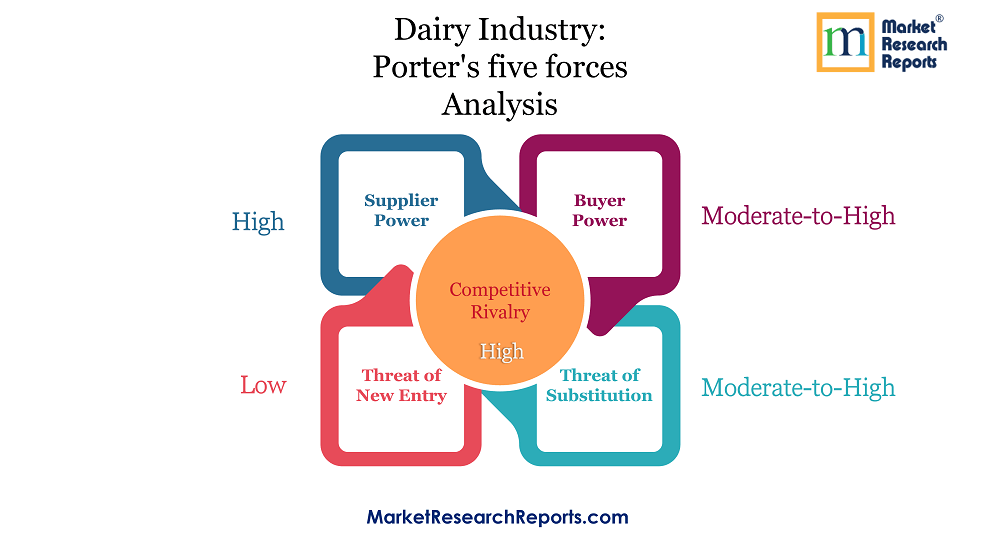Competitive Analysis of the Global Dairy Market with Porter's Five Forces Model

The dairy industry is a mature and highly competitive market, with a wide range of products and a diverse group of players. I have included the prevailing industry scenario under five forces in different parts of the world in this competitive analysis.
In terms of geography, the dairy industry is different in different parts of the world. The dairy industry is highly competitive in the United States, Europe, and Australia, with many large and small companies vying for market share. In the Middle East and Africa, the industry is still relatively underdeveloped, and there are opportunities for new companies to enter the market. In India, the market is dominated by a few large companies but also has many small and medium-sized farmers and cooperatives.
1 . Global Dairy Market Current Status
The Global Dairy Market had total revenues of USD 594,992.3 million in 2021, representing a compound annual growth rate (CAGR) of 5.0% between 2016 and 2021. The market consumption volume increased with a CAGR of 2.5% between 2016 and 2021 to reach 208,865.0 million kilograms in 2021.
The performance of the market is forecast to accelerate, with an anticipated CAGR of 6.5% for the five years 2021 - 2026, which is expected to drive the market to a value of USD 818,343.8 million by the end of 2026.
The market consists of retail sales of butter & spreadable fats, cheese, cream, dairy-based & soy-based desserts, drinkable yogurt, fromage frais & quark, milk, milk alternatives (grain, nut, rice, seed alternatives), soymilk & soy drinks, yogurt.
2 . Porter's Five Forces Analysis of the Dairy Industry
The industry is characterized by high barriers to entry, competition from substitute products, and significant bargaining power held by suppliers and buyers. These factors make it difficult for new companies to enter the market and for existing companies to achieve sustainable competitive advantage.

Threat of New Entrants:
The dairy industry has high barriers to entry, including economies of scale, government regulations, and brand recognition. For example, to enter the market, new companies would need to invest in expensive equipment and facilities and comply with regulations related to food safety and labeling. Additionally, established companies have a strong brand recognition that new companies would need to compete with.
In the Middle East and Africa, the threat of new dairy industry entrants is considered moderate. The dairy industry in these regions is still relatively underdeveloped; therefore, it does not have the same high barriers to entry as more developed markets.
However, there are still some challenges that new companies may face when entering the market. For example, the dairy industry in these regions is dominated by a few large companies, such as Almarai and FrieslandCampina, making it difficult for new companies to gain market share. Additionally, there may be challenges related to infrastructure and logistics, as well as regulations and compliance.
Despite these challenges, there are also opportunities for new companies to enter the market. For example. the South African Dairy market alone had total revenues of $9,867.1 million in 2021. There is a growing demand for milk and milk products in the Middle East and Africa, driven by population growth and urbanization. Additionally, there is a large untapped market for organic and specialty dairy products.
Threat of Substitute Products:
The dairy industry faces competition from substitute products such as soy and almond milk, which can be used as substitutes for cow's milk. For example, companies such as Silk and Almond Breeze have gained market share in the milk alternative market, which can impact the sales of traditional dairy milk producers.
In North America, the threat of substitute products in the dairy industry is considered to be high. The market for non-dairy alternatives, such as soy, almond, and oat milk, has grown rapidly in recent years. These products have become increasingly popular among consumers looking for alternatives to cow's milk.
Large companies such as Silk, Almond Breeze, and Oatly have gained market share in the non-dairy milk alternative market, which can impact the sales of traditional dairy milk producers. Within the dairy industry, the US is the leading country among the NAFTA bloc, with market revenues of $78,297.4 million in 2021.
The growing consumer demand for plant-based and non-dairy products and concerns about health, sustainability, and animal welfare drive this trend.
Additionally, non-dairy milk alternatives are becoming more widely available, and they are being sold in many of the same outlets as traditional dairy milk, such as supermarkets, coffee shops, and restaurants, increasing competition.
On the other hand, some consumers still prefer traditional dairy milk's taste, texture, and nutritional value, which limits the threat of substitute products.
Bargaining Power of Suppliers:
The dairy industry is dominated by a small number of large suppliers, which gives them significant bargaining power. For example, large milk producers such as Dean Foods and Dairy Farmers of America have substantial influence over the price and availability of milk, which can impact the profitability of companies that rely on milk as an input.
In Australia, the bargaining power of suppliers in the dairy industry is considered to be moderate. The dairy market in Australia is forecast to accelerate, with an anticipated CAGR of 6.4% , the industry is dominated by a small number of large suppliers, such as Murray Goulburn and Fonterra, which gives them some bargaining power when it comes to pricing and terms of supply.
However, the industry has also faced challenges recently, such as declining milk production and falling prices. These challenges have led to a decline in the bargaining power of suppliers, as they are increasingly dependent on major processors and retailers for their livelihood.
Additionally, the Australian dairy industry is also facing competition from imported dairy products and alternative milk sources, such as almond milk, soy milk, and oat milk which also limits the bargaining power of suppliers.
On the other hand, there are also small and medium-sized dairy farmers in Australia who are part of cooperatives; these cooperatives have more bargaining power as they have a strong distribution network and can negotiate better prices and terms with processors and retailers.
Bargaining Power of Buyers:
The dairy industry is also dominated by a small number of large buyers, such as supermarkets and food processors, which gives them significant bargaining power. For example, large retailers such as Walmart and Kroger have considerable influence over the price and terms of the products they purchase from dairy companies, which can impact the suppliers' profitability.
In India, the bargaining power of buyers is considered to be moderate. The Indian dairy market is dominated by many small and medium-sized farmers and milk cooperatives, with a few large players such as Amul, Mother Dairy, and Nestle. These small and medium-sized farmers and cooperatives have limited bargaining power when selling their milk to large buyers like dairy processors and retailers.
However, the scenario is different for large dairy companies in India have more bargaining power as they have a strong distribution network and brand recognition. They can negotiate better prices and terms with retailers and processors. In India, dairy market consumption volume increased with a CAGR of 11.6% between 2016 and 2021, to reach a total of 26,499.8 million kilograms in 2021.
Additionally, India has a large population and a growing middle class which has created a strong demand for milk and milk products, this has also given more bargaining power to the buyers.
Rivalry Among Existing Competitors:
The dairy industry is highly competitive, with many large and small companies vying for market share. For example, large companies such as Nestle and Danone compete with smaller, regional companies such as Land O'Lakes and Hiland Dairy for market share in the milk, cheese, and yogurt segments.
In Europe, the rivalry among competitors in the dairy industry is considered high. The European Union (EU) is the world's largest producer and exporter of milk and milk products, and the industry is highly competitive with many large and small companies vying for market share. In Europe dairy market consumption volume increased with a CAGR of 1.1% between 2016 and 2021.
Several major players in the European dairy industry, such as Danone, Lactalis, and Nestle, have a significant market share in the region. These companies have strong brands and established distribution networks, which allows them to compete effectively in the market.
In addition to these large companies, many small and medium-sized companies, such as regional dairy cooperatives and family-owned businesses, compete in the market. These companies may have more limited resources, but they can often compete effectively by focusing on niche products or local markets.
The competition in the European dairy industry is also influenced by the EU's Common Agricultural Policy, which regulates the production and pricing of milk and milk products. This policy can impact the profitability of companies operating in the market.
3 . How can Market Research help conduct a competitive analysis of the dairy industry?
- Identifying opportunities and threats: Market research helps companies analyze the industry's competitive landscape and identify opportunities to gain market share and threats that may impact their profitability.
- Benchmarking performance: A well-researched competitive analysis can help companies benchmark their performance against their competitors, allowing them to identify areas where they need to improve.
- Developing strategic plans: The insights gained from a competitive analysis can inform the development of strategic plans, such as marketing and product development strategies.
- Identifying critical success factors: A competitive analysis can help companies identify the key success factors for the industry, such as economies of scale, brand recognition, and distribution networks, which can inform decision-making.
- Assessing the potential of new markets: A competitive analysis conducted by a market research company provides several inputs that dairy companies can use to evaluate the possibility of new markets, such as emerging markets in the Middle East and Africa, and help companies identify the best growth opportunities.





